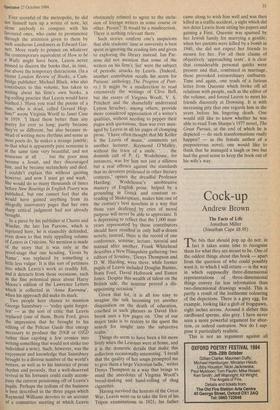Cock-up
Andrew Brown
The Facts of Life Jonathan Miller (Jonathan Cape £8.95)
The bits that should pop up do not: in fact it takes some time to recognise them for what they are meant to be. One of the oddest things about this book — apart from the question of who could possibly want it, to which I will return — is the way in which supposedly three-dimensional representations of three-dimensional things convey far less information than two-dimensional drawings would. This is partly a result of the loathsome colouring of the depictions. There is a grey egg, for example, looking like a glob of frogspawn, eight inches across. Around it slither thin cardboard sperms, also grey. I have never seen a more powerful argument for abor- tion, or indeed castration. Nor do I sup- pose it particularly realistic.
This is not an argument against all illustrations. Plain line drawings do ex- plain, because they simplify. But the Miller pop-up guide to copulation offers instead the sort of confusion you would find if you dissected a woman to find out how she worked, though this confusion is all that it has in common with real life. Any effect of depth, or solidity, is produced by the traditional, two-dimensional trieks of painting. As soon as the painted cardboard rises from the page, the illusion -is des- troyed. The baby's head becomes a triang- le of paper; while, in what appears to be a misprint, the egg retreats from womb to ovary when threatened with fertilisation.
Most of the colours are variants of that strange bloody pink made famous by Len- nart Nillson's photographs of babies grow- ing in the womb, but when the book gets didactic it really goes over the top. A man with one leg and a vermilion bladder, violet stomach and testicles and a scarlet dork is seen putting it into another amputee with a bright green bladder and gold, glittering deposits of fat all down her backbone.
The commentary improves the joke b'y pretending that these creatures are human beings. Apparently your bladder will not turn green, nor your left testicle develop an armour of blue corrugated steel, until puberty, which leaves me wondering when that will happen. Can such creatures inter- breed with humans at all? My wife, a nurse, remarked that one of the babies in the womb was clearly out of position and would be still-born, so perhaps Miller's monsters can never breed on earth.
The book has probably a more shocking effect on adults than on children, for adults can also be depressed by the banality of the text, which is printed in two different sizes, still further to confuse the issue. But small healthy children are not frightened by things which they know can never happen to them. When my son was four, he got hold of a book on skin diseases published by a drug company. Page after page of glossy colour photographs of skin cancers, leprosy, herpes, syphilitic sores: you name it, they had it. Yet he was never shocked or disgusted by the book — as I was — since it did not occur to him that these diseases might afflict anyone he knows. So The Facts of Life could quite safely be given to children below the age of vegetarianism that moment when they realise that 'chick- en' on the plate is the same bird as 'chicken' in a field. I don't think they would learn anything from it. If adults can't believe that these pictures are of human beings, why should children? But they would have fun tearing it to bits, and it is ingeniously made.
The real purpose of the book must be humanitarian. If I were cast away on a desert island, or condemned to a long spell of imprisonment, this is one book that I would want to have with me, so as to convince myself that I was missing nothing of importance. Come to think of it, perhaps another Spectator contributor should have been asked to do this review.



















































 Previous page
Previous page